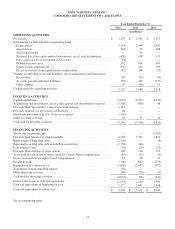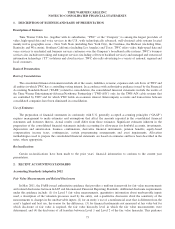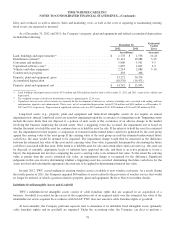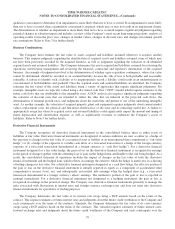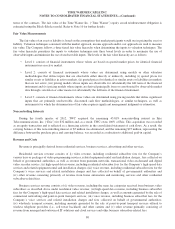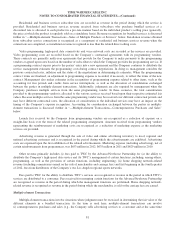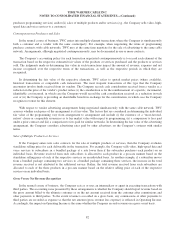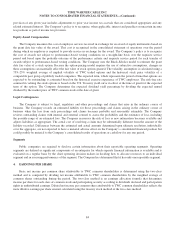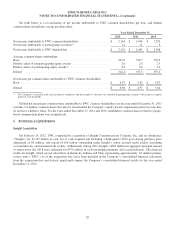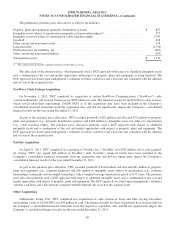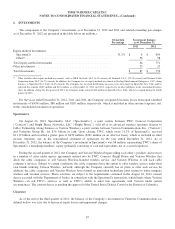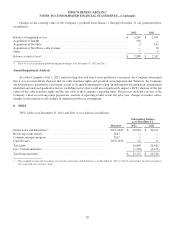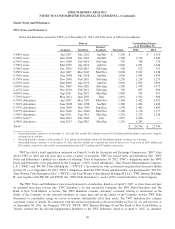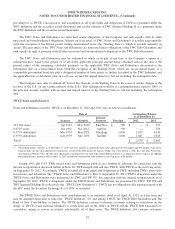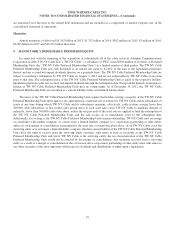Time Warner Cable 2012 Annual Report Download - page 93
Download and view the complete annual report
Please find page 93 of the 2012 Time Warner Cable annual report below. You can navigate through the pages in the report by either clicking on the pages listed below, or by using the keyword search tool below to find specific information within the annual report.TIME WARNER CABLE INC.
NOTES TO CONSOLIDATED FINANCIAL STATEMENTS—(Continued)
For example, TWC is assessed franchise fees by franchising authorities, which are passed on to the customer. The
accounting issue presented by these arrangements is whether TWC should report revenue based on the gross amount billed to
the ultimate customer or on the net amount received from the customer after payments to franchising authorities. The
Company has determined that these amounts should be reported on a gross basis. TWC’s policy is that, in instances where
the fees are being assessed directly to the Company, amounts paid to the governmental authorities and amounts received
from the customers are recorded on a gross basis. That is, amounts paid to the governmental authorities are recorded as cost
of revenue and amounts received from the customer are recorded as revenue. The amount of such fees recorded on a gross
basis related to video and voice services was $684 million in 2012, $610 million in 2011 and $585 million in 2010.
Accounting for Pension Plans
TWC sponsors two qualified defined benefit pension plans covering a majority of its employees. TWC also provides a
nonqualified defined benefit pension plan for certain employees. Pension benefits are based on formulas that reflect the
employees’ years of service and compensation during their employment period. The pension expense recognized by the
Company is determined using certain assumptions, including the expected long-term rate of return on plan assets, the interest
factor implied by the discount rate and the expected rate of compensation increases.
Income Taxes
Income taxes are provided using the asset and liability method.Under this method, income taxes (i.e., deferred tax
assets, deferred tax liabilities, taxes currently payable/refunds receivable and tax expense) are recorded based on amounts
refundable or payable in the current year and include the results of any difference between GAAP and tax reporting. Deferred
income taxes reflect the tax effect of net operating losses, capital losses, general business credit carryforwards and the net tax
effects of temporary differences between the carrying amount of assets and liabilities for financial statement and income tax
purposes, based upon enacted tax laws and expected tax rates that will be in effect when the temporary differences reverse.
Valuation allowances are established when management determines that it is more likely than not that some portion or the
entire deferred tax asset will not be realized. The financial effect of changes in tax laws or rates is accounted for in the period
of enactment.
Prior to TWC’s separation from Time Warner on March 12, 2009 (the “Separation”), TWC was not a separate taxable
entity for U.S. federal and various state income tax purposes and its results were included in the consolidated U.S. federal
and certain state income tax returns of Time Warner. The income tax benefits and provisions, related tax payments, and
current and deferred tax balances have been prepared as if TWC operated as a stand-alone taxpayer for all periods presented
including periods through the date of the Separation. Under a tax sharing arrangement between TWC and Time Warner and
with respect to periods prior to the Separation, TWC is obligated to make tax sharing payments to Time Warner in amounts
equal to the estimated taxes it would have paid if it were a separate taxpayer and Time Warner is obligated to make payments
to TWC for TWC tax attributes used by Time Warner, but only as and when TWC as a standalone taxpayer would have been
able to use such attributes itself. The Company received net cash tax refunds from Time Warner of $6 million in 2012 and
$87 million in 2010.
From time to time, the Company engages in transactions in which the tax consequences may be subject to uncertainty.
Examples of such transactions include business acquisitions and dispositions, including dispositions designed to be tax free,
issues related to consideration paid or received, investments and certain financing transactions. Significant judgment is required
in assessing and estimating the tax consequences of these transactions. The Company prepares and files tax returns based on
interpretation of tax laws and regulations. In the normal course of business, the Company’s tax returns are subject to
examination by various taxing authorities. Such examinations may result in future tax, interest and penalty assessments by these
taxing authorities. In determining the Company’s income tax provision for financial reporting purposes, the Company
establishes a reserve for uncertain income tax positions unless such positions are determined to be more likely than not of being
sustained upon examination, based on their technical merits. That is, for financial reporting purposes, the Company only
recognizes tax benefits taken on the tax return that it believes are more likely than not of being sustained. There is considerable
judgment involved in determining whether positions taken on the tax return are more likely than not of being sustained.
The Company adjusts its tax reserve estimates periodically because of ongoing examinations by, and settlements with,
the various taxing authorities, as well as changes in tax laws, regulations and interpretations. The consolidated income tax
83


